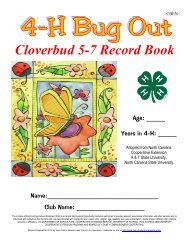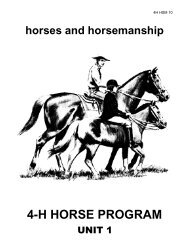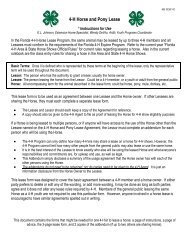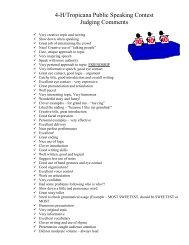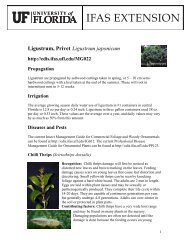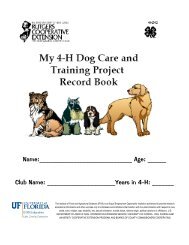Fig Wax Scale (Ceroplastes rusci)
Cycad Aulacaspis Scale - Lake County Extension
Cycad Aulacaspis Scale - Lake County Extension
- No tags were found...
You also want an ePaper? Increase the reach of your titles
YUMPU automatically turns print PDFs into web optimized ePapers that Google loves.
Exotic Pests – What to Look For<strong>Fig</strong> <strong>Wax</strong> <strong>Scale</strong> (<strong>Ceroplastes</strong> <strong>rusci</strong>)Introduced: 1994-1995Current Infestation: Brevard, Broward, Charlotte, Collier, Hillsborough, Lee, Manatee,Miami-Dade, Orange, Palm Beach, Pasco, Pinellas, Seminole, St. Johns, and St. LucieDescription/Biology: The fig wax scale looks like a typical wax scale, which isrelatively large, globular and coated with a layer of beige, pinkish, or whitish wax.<strong>Scale</strong>s on the twigs eventually appear to lose the wax coating and look more smoothand brown in color. Adult females scales are typically found on the branches. Thecrawler stage, which hatches from the eggs, will move to the leaves to feed. The scaleis found on both the upper and lower surface of leaves. The immature stages (nymphs)tend to be oval, slightly flat and have a star-like appearance due to the production ofwax. Nymphs eventually migrate from the leaves to leaf petioles or to new shoots tocontinue their development. The life cycle is approximately 3 months. These scalesproduce heavy amounts of honeydew which causes severe growth of sooty mold.Host Range: The fig wax scale has been reported on a broad range of host plantswhich include numerous important ornamental and fruit crops. In Florida, it has beenreported on sugar apple, mimusops, pygmy date palm, Ixora, and more recently ficus.Damage: Leaf yellowing, defoliation, and branch dieback have been associated withheavy populations of this pest. The heavy production of honeydew and subsequentgrowth of sooty mold is very evident on the host plant as well as on surrounding plantsand environment.Management: In the landscape, several natural enemies (parasites) have beenobserved attacking this scale. Protecting natural enemies may be a critical componentin the long-term control of this pest. The current recommendation is to drench the soilaround the base of the tree or hedge with a product that contains a neonicotinoidcompound (clothianidin, dinotefuran, imidacloprid, or thiamethoxam). Insecticides thatcan be applied to the foliage for control include Aria (flonicamid), Azadirachtin, Distance(pyriproxyfen), Talus (buprofenzin), and Tristar (acetamiprid) as well as horticultural oiland insecticidal soap. However, soil application of a systemic product is expected toprovide longer lasting control and to be less detrimental to the natural enemies.http://edis.ifas.ufl.edu/IN344Photo Credit: H. Glenn, UF/IFASCatharine MannionUF/IFAS Tropical Research and Education Centercmannion@ufl.eduMay 2008
Exotic Pests – What to Look ForIntroducido: 1994-1995Escama cerosa del higo (<strong>Ceroplastes</strong> <strong>rusci</strong>)Infestación Actual: Brevard, Broward, Charlotte, Collier, Hillsborough, Lee, Manatee,Miami-Dade, Orange, Palm Beach, Pasco, Pinellas, Seminole, St. Johns, y Sta. LucíaDescripción/Biología: La escama cerosa del higo parece una escama típica cerosa,es relativamente grande, globular y cubierta con una capa de cera amarillenta, rosácea,o blanquecina. Las escamas ubicadas en las ramitas parecen perder la capa de cera yson más lisas y de color marrones. Las escamas hembras adultas se encuentrantípicamente en las ramas. La etapa de ninfa móvil que eclosiona de los huevos semueve a las hojas para alimentarse, pudiéndose encontrar en la superficie superior einferior de las hojas. Las etapas inmaduras (ninfas) tienden a ser ovales, levementeplanas y tienen un aspecto estrellado debido a la producción de cera. Las ninfasemigran de las hojas hacia los pecíolos o los nuevos brotes para continuar con sudesarrollo. El ciclo de vida es de aproximadamente 3 meses. Estas escamas producengrandes cantidades de secreciones azucaradas, lo que causa mucho crecimiento defumagina.Rango de hospederos: La escama cerosa del higo se ha reportado que afecta unaamplia gama de plantas incluyendo plantas frutales y ornamentales. En la Florida, seha reportado que afectan guanábana, mimusops, pygmy date palm, ixora, y ficus.Daños: Amarillamiento de la hoja, defoliación y muerte regresiva de ramas se hanasociado cuando hay altas poblaciones de la plaga. La gran producción de secrecionesazucaradas y el crecimiento subsecuente de fumagina en la planta hospedera así comoa su alrededor es un síntoma evidente de la presencia de la escama.Manejo: En los jardines se ha observado varios enemigos naturales (parásitos) queatacan a ésta escama. La protección de los enemigos naturales es un componentecrítico en el control de la escama a largo plazo. La recomendación actual es mojar obañar el suelo alrededor de la base del árbol con un producto que contenga elcompuesto neonicotinoid (clothianidin, dinotefuran, imidacloprid, o thiamethoxam).Algunos insecticidas que se pueden aplicar al follaje para el control son:Aria(flonicamid), Azadirachtin, Distance (pyriproxyfen), Talus (buprofenzin), y Tristar(acetamiprid) así como el aceite hortícola y el jabón insecticida. Sin embargo, el uso deun producto sistémico al suelo proporcione un control más más duradero y es menosperjudicial a los enemigos naturales.http://edis.ifas.ufl.edu/IN344Traducción: Henry Mayer, UF/IFAS, Miami-Dade ExtensionRevisión: Carlos Balerdi y Rubén Regalado, UF/IFAS, Miami-Dade ExtensionCatharine MannionUF/IFAS Tropical Research and Education Centercmannion@ufl.eduMay 2008







